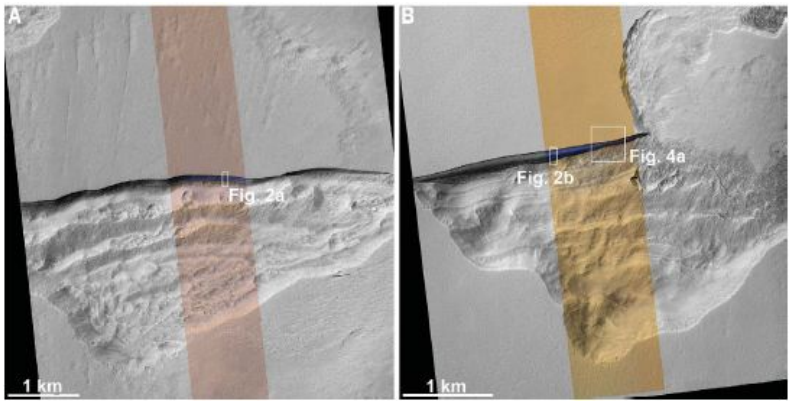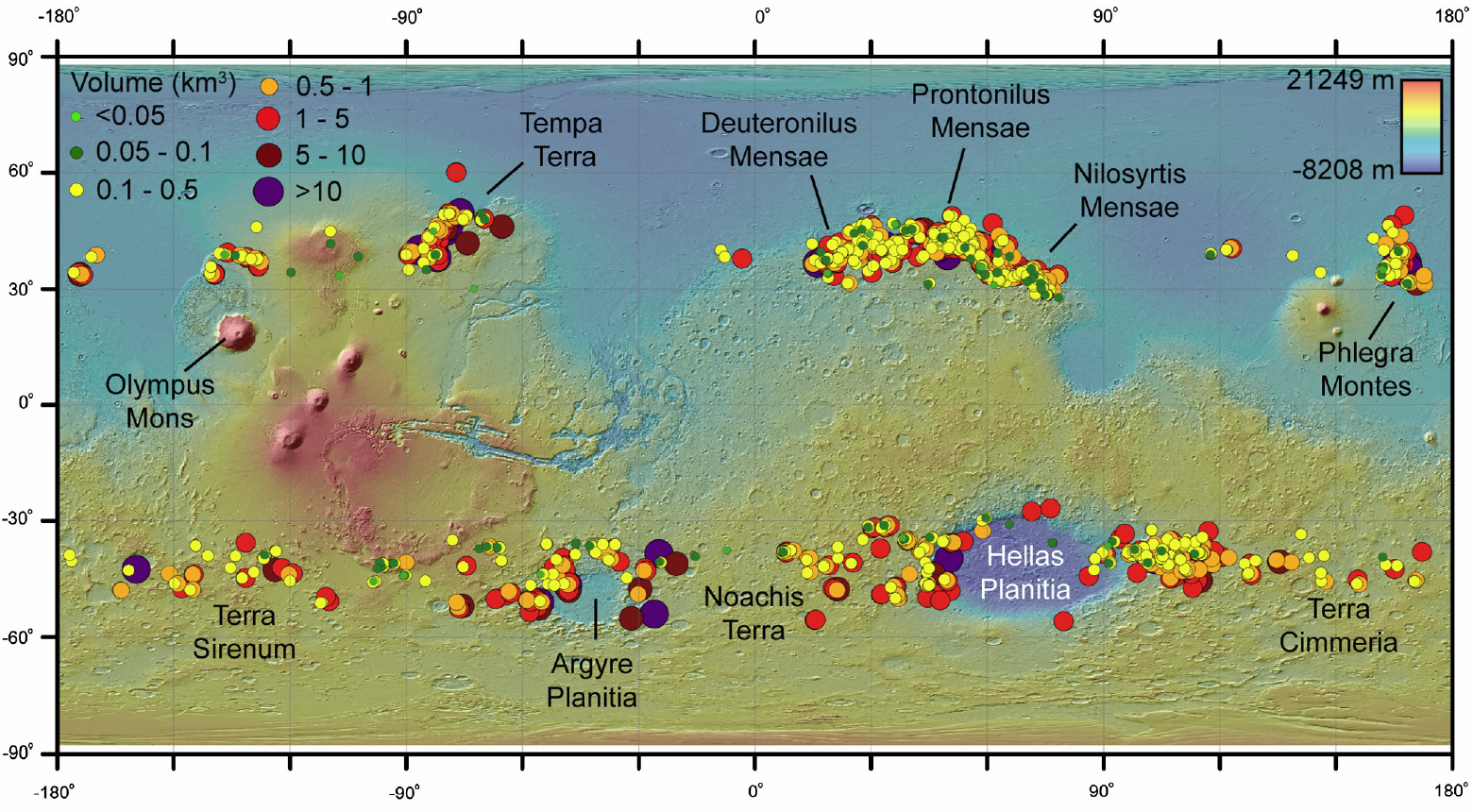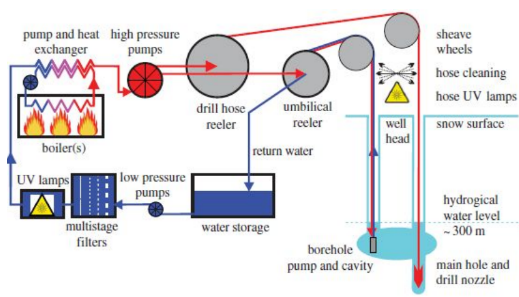Martian Glaciers, Plentiful and Accessible
Mosaic of Mars composed of 102 Viking Orbiter images. Credit: NASA/JPL-Caltech
Mars is a treasure chest full of resources. Of all the available resources on Mars, water is the resource with the greatest utility. Aside from the possibility that it can contain extra-terrestrial life, it can be used for creating fuels and oxidizers, drinking water, agriculture, chemical processes, and more. The key question to resolve is: Where on Mars can we find large quantities of water that are easily accessible? Martian glaciers at mid-latitudes hold promise for being that ideal source.
Any visitor to Mars must either rely on local materials or those brought from elsewhere. The prospect of utilizing resources from a destination in space is called in-situ resource utilization (ISRU). This concept is vital for establishing self sufficiency on Mars, along with vastly reducing mission costs. The many uses for water make it a great first target for ISRU, but it must be produced and processed in large quantities using methods feasible for early missions.
It has been known for some time that water currently exists on Mars in one form or another. This includes sources in regolith, brines, the atmosphere, and even widespread glacial ice at the Martian poles. These polar ice caps are substantial, spanning 1 million km² (over 386 thousand square miles) with a thickness of 3 to 4 km (2 to 2.5 miles).
Map showing the Mars global climate zones. It is based on temperature and is modified by topography, albedo, and the actual solar radiation. A=Glacial (permanent ice cap); B=Polar (covered by frost during the winter which sublimates during the summer); C=North (mild) Transitional (Ca) and C South (extreme) Transitional (Cb); D= Tropical; E= Low albedo tropical; F= Subpolar Lowland (Basins); G=Tropical Lowland (Chasmata); H=Subtropical Highland (Mountain). Credit: Hargitai et al. 2010.
Exciting recent research has also found water to exist in plentiful glacial forms in the mid-latitude regions of Mars. These mid-latitude regions lie both north and south of the equator, between 30° and 60°. The importance of this finding is that it identifies a source of water which is both accessible and plentiful. These mid-latitude regions are far more hospitable than the poles to early human settlements. In terms of Mars climate, the northern mid-latitudes are a mild transitional climate zone.
While there is a small percentage of water in Mars regolith and in the atmosphere, the majority of water in mid-latitude regions is found in glacial ice. For many years there was speculation that such ice could exist on Mars. In 2016, results from the NASA Mars Reconnaissance Orbiter (MRO) SHARAD instrument found massive mid-latitude layers of over 90% water ice. These layers were determined to be hundreds of meters (100 m is about 328 feet) thick and covered by a debris layer 0.5 m to 10 m (2 to 33 feet) thick. Based on that, the amount of ice present in mid-latitude glacial ice constitutes a volume of water 10 times that of the North American Great Lakes. This is also equivalent to 19% of the water contained in Mars’ North Polar Layered Deposit (NPLD), the largest water ice deposit on Mars.
Orbiter images of scarps on Mars which exposed ice sheets. Captured by NASA’s MRO HiRISE instrument. Credit: Dundas et al. 2018.
In 2018, some of these mid-latitude glacial ices were directly imaged by the MRO HiRISE instrument. The images showed erosional scarps (surface features where a section of ground has moved vertically away from its original location through erosion) exposing layered ice sheets. As expected from MRO SHARAD data, the glacial ice sheets directly observed at these locations are greater than 100 meters (328 feet) thick. They were identified at eight mid-latitude locations. This discovery further characterizes the now known existence of mid-latitude water ice on Mars.
Map of Mars showing known mid-latitude glaciers and their relative volume. Global glacier volume is 1743.60 km³, with 1045.10 km³ in northern hemisphere and 698.49 km³ in the southern hemisphere. Credit: Brough et al. 2018.
By now many mid-latitude deposits of glacial ice have been identified, ranging vastly in size. Most deposits are between 0.1 km³ and 5 km³ (.02 to 1.2 cubic miles), however, a few are well over 10 km³ (2.4 cubic miles). In total, the total Martian glacial volume is currently estimated to be over 1700 km³ (408 cubic miles) in volume, or about the volume of Lake Ontario.
Despite now knowing that plentiful water exists on Mars, many details remain unresolved such as the specifics of glacial ices’ layers and composition. Also, it is unknown whether a firn (partially compacted granular snow) layer exists between the surface overburden layer and the glacial ice sheets. This firn layer is seen on Earth, but some suspect this layer is missing on Mars since snowfall plays a primary role in its formation on Earth.
Rodwell development process. Credit: Linne et al. 2017.
Actually processing Martian glaciers for water is a straight forward task since the water concentration is already high. However, impurities need to be dealt with. There are multiple approaches for extracting water from glacial ice, including mechanical and hot-water drilling, wireline methods, and Rodriguez wells (Rodwells).
Rodwells are an attractive option for extracting water from frozen bodies of water. Developing a Rodwell involves drilling through the overburden to expose the ice. Then the ice is melted using heated water. Melt water pools at the bottom of the melt shaft, which is then pumped to the surface for further processing. Some of that melt water is then re-heated and returned to the well to keep the melt water pool liquid and to further melt ice. Rodwells are a good option for extracting water from glaciers because they are relatively simple and allow large extraction rates. Because of this they are used extensively in Antarctica to produce water.
The plentiful glacial source of water on Mars holds great promise. However, the potential for liquid water raises questions such as whether it currently supports or previously supported extra-terrestrial life. Until we prove no extra-terrestrial life exists around these Martian glacial regions, early glacial exploration missions should utilize special drilling systems to prevent biological contamination. On Earth, subglacial exploration uses methods that prevent biological contamination.
Schematic of a Clean Hot Water Drill System for preventing contamination during subglacial exploration. Credit: Makinson et al. 2016.
Clean Hot Water Drills (CHWDs) are one such system that can minimize this biological contamination. These drills filter and treat their drilling water for microbial and particulate content before use. On Earth, operators of CHWD targeting subglacial zones must comply with a code of conduct for subglacial exploration. This code of conduct was created by the Scientific Committee on Antarctic Research (SCAR). A similar set of standards and processes would be good to study and adapt as a precaution on Mars, even when not intending to reach a subglacial region.
The identified Martian mid-latitude glacial deposits promise vast reservoirs of accessible water. These deposits have the potential to be the backbone of any future sustainable mission to, or settlement on, Mars. However, we must be cognizant for the potential of extra-terrestrial life in these zones. While fears of impacting alien life shouldn’t stop exploration, reasonable steps should be taken to ensure a chance to study something truly alien isn’t ruined. This is likely to cause friction between scientists, engineers, and commercial interests, but we must have the conversation and determine how to handle this now.
RESOURCES
Abbud-Madrid, A., Beaty, D., Boucher, D., Bussey, B., Davis, R., Gertsch, L., Hays, L., Kleinhenz, J., Meyer, M., Moats, M. and Mueller, R., 2016. Mars Water In-Situ Resource Utilization (ISRU) Planning (M-WIP) Study. Report of the Mars Water In-Situ Resource Utilization (ISRU) Planning (M-WIP) Study, 90.
Beaty, D.W., Mueller, R.P., Bussey, D.B., Davis, R.M., Hays, L.E., Hoffman, S.J. and Zbinden, E., 2016. Some Strategic Considerations Related to the Potential Use of Water Resource Deposits on Mars by Future Human Explorers. Earth and Space, p.437.
Linne, D., Kleinhenz, J., Trunek, A., Hoffman, S. and Collins, J., 2017. Extraction of Volatiles from Regolith or Soil on Mars, the Moon, and Asteroids.
Brough, S., Hubbard, B., Hubbard, A., 2018. Area and volume of mid-latitude glacier-like forms on Mars.
Cockell, C.S., 2004. The uses of Martian ice. Interdisciplinary Science Reviews, 29(4), pp.395-407.
Dundas, C.M., Bramson, A.M., Ojha, L., Wray, J.J., Mellon, M.T., Byrne, S., McEwen, A.S., Putzig, N.E., Viola,D., Sutton, S. and Clark, E., 2018. Exposed subsurface ice sheets in the Martian mid-latitudes. Science, 359(6372), pp.199-201.
Hargitai, H., 2010. Mars Climate Zone Map Based on TES Data.
Hoffman, S.J., Andrews, A., Joosten, B.K. and Watts, K., 2017. A Water Rich Mars Surface Mission Scenario.
Makinson, K., Pearce, D., Hodgson, D.A., Bentley, M.J., Smith, A.M., Tranter, M., Rose, M., Ross, N., Mowlem, M., Parnell, J. and Siegert, M.J., 2016. Clean subglacial access: prospects for future deep hot-water drilling. Phil. Trans. R. Soc. A, 374(2059), p.20140304.
Rapp, D., 2013. Use of extraterrestrial resources for human space missions to moon or mars. Springer.












